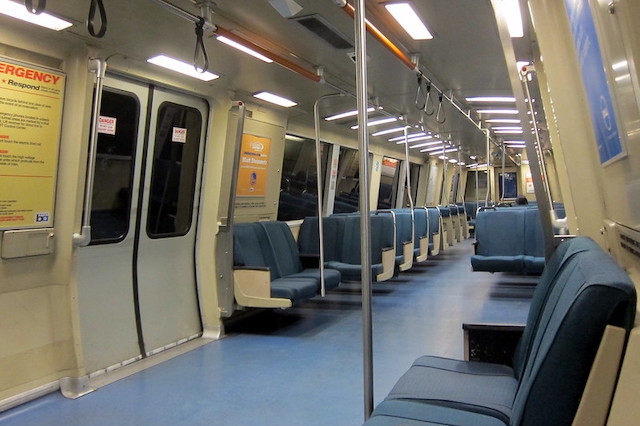California transit agency warnings about a fiscal cliff may be falling on deaf ears in Sacramento. Although transit activists are becoming increasingly shrill, the state legislature has good reasons to ignore them.
Not much point in bailing out a transit agency that is running empty trains. Photo by Wally Gobetz.
One reason is that the state has its own funding problems. Earlier this year, it was projecting a $10 billion budget deficit, but that has recently increased to more than $32 billion.
Second, the only transit agency that is really in trouble is BART. Before the pandemic, BART received a higher percentage of its operating funds from fares than almost any other transit agency in the nation, which made it more vulnerable to a decline in ridership. Agencies such as the Santa Clara Valley Transportation Authority that received less than 10 percent of their funding from fares didn’t lose much from a COVID-related decline in ridership.
BART is also suffering a bigger decline in ridership than most California agencies. As of March, BART carried less than 42 percent of pre-pandemic riders, compared with 84 percent for San Diego MTS, 73 percent for LA Metro, and 70 percent for Sacramento’s RTD. While other agencies may eventually have fiscal cliffs of their own, they will be smaller and won’t happen as soon as BART’s.
Legislators may have little sympathy for BART due to the recent resignation of the agency’s inspector general amid charges that the agency refused to cooperate with her investigations. This left the agency smelling of corruption. Suddenly, multi-billion-dollar projects to extend BART’s route system don’t seem so important when ridership is less than half of what it was and people are beginning to wonder who is really getting all of that money.
State senator Steve Glazer, whose district is served by BART, says that he won’t support additional funding for BART until it is willing to accept fiscal oversight by the inspector general’s office. “BART doesn’t deserve a bailout,” argues local reporter Daniel Borenstein, as the agency has been acting “childish and fiscally reckless” by refusing to reduce its spending despite the decline in ridership.
Considering that most of the people in the San Francisco Bay Area who have discovered the joys of working at home have made it plain that they are not going to go back to doing morning and evening commutes, BART is not going to get all of its former customers back. Needless to say, one of the weaknesses of infrastructure-heavy transit systems is that they can’t easily respond to unforeseen changes in travel habits.
Unless the legislature caves, BART may have to do what so many other businesses have done since the pandemic: reduce its costs. BART actually offered only 63 percent as many vehicle-miles of service in 2021 as 2019, mainly by running shorter trains, but it only reduced its costs by 5 percent. With ridership down nearly 60 percent, it should be running fewer trains, not just shorter ones.









2017 California passed senate Bill I forget the number. But basically repealed the States 4 decade long mandate requiring state transit agencies to meet specific farebox recovery ratios…which back then was 35%. Me suspects they did it because as HSR costs exploded tangible financial returns would materialize.
In any case California has long severed agency responsibilities for providing actual transportation services. 1990s they cut bus services prompting NAACP to sue.
Jitney’s were common in San Francisco up til the 70’s. In the 1910s, there were 1,400 jitneys operating in the city, according to SFMTA records, and they remained ubiquitous into the 1970s, patronized by the city’s Asian and Latin community. But around that time the city wanted to encourage public transit use on MUNI and BART. It disliked the competition, so began issuing fewer permits and forcing jitneys to raise fares, as not to undercut the public option. In 1978, the city stopped issuing permits altogether and Jitney’s were sunk. When Chariot started in 2010s following a wave of deregulation they swiftly took market share and by 2015 carrying 50,000 daily riders.
https://www.sfmta.com/projects/private-transit-vehicle-permitting
Government cronyism 101, If it competes with us it must go…
it’s still bad news to me that bart gets singled out because they’re the one that depends on fare box revenue the most, because they’ll argue to be released from the surly bonds of running a transportation service by being supported even more by non-riding taxpayers.
only if california examines where all their public transit money is going do they get out of the patronage mess they’ve created for themselves.